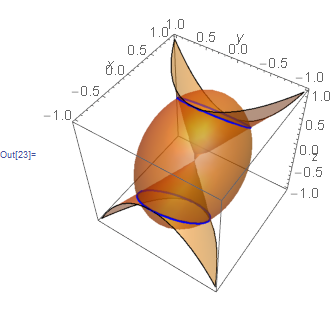I have the two equations
$x^2 + 2y^2 + z^2 = 1$ and
$xz -y^2 = 0$
I want to plot the roots in 3D. i.e the coordinates $x,y$ znd $z$
I assume by roots you mean where the 2 surfaces intersect? Using example from help that shows the intersection of 2 surfaces, first we get an idea of the intersection
h = x^2 + y^2 + z^2 - 2;
g = x z - y^2;
s=ContourPlot3D[{h == 0, g == 0}, {x, -1, 1}, {y, -1, 1}, {z, -1, 1},
MeshFunctions -> {Function[{x, y, z, f}, h - g]},
MeshStyle -> {{Thick, Blue}}, Mesh -> {{0}},
ContourStyle ->
Directive[Orange, Opacity[0.5], Specularity[White, 30]],
AxesLabel -> {x, y, z}, BaseStyle -> 14]


so it looks like all points at 2 circles some distance from origin:
Reduce[h == g, {x, y, z}]

So, all points that meet the above conditions are your "roots". For example:
FindInstance[h == g, {x, y, z}]

Show[s, Graphics3D[{Red, PointSize[.05], Point[{-1, 0, 0}]}]]
